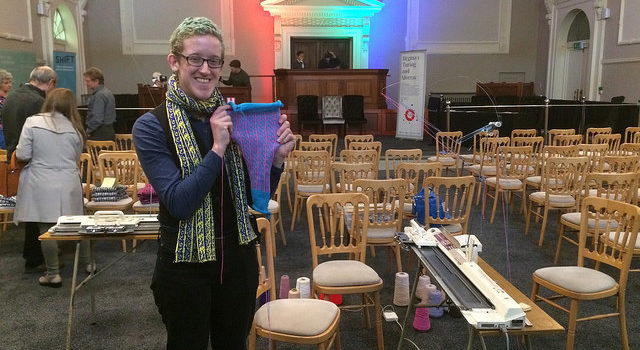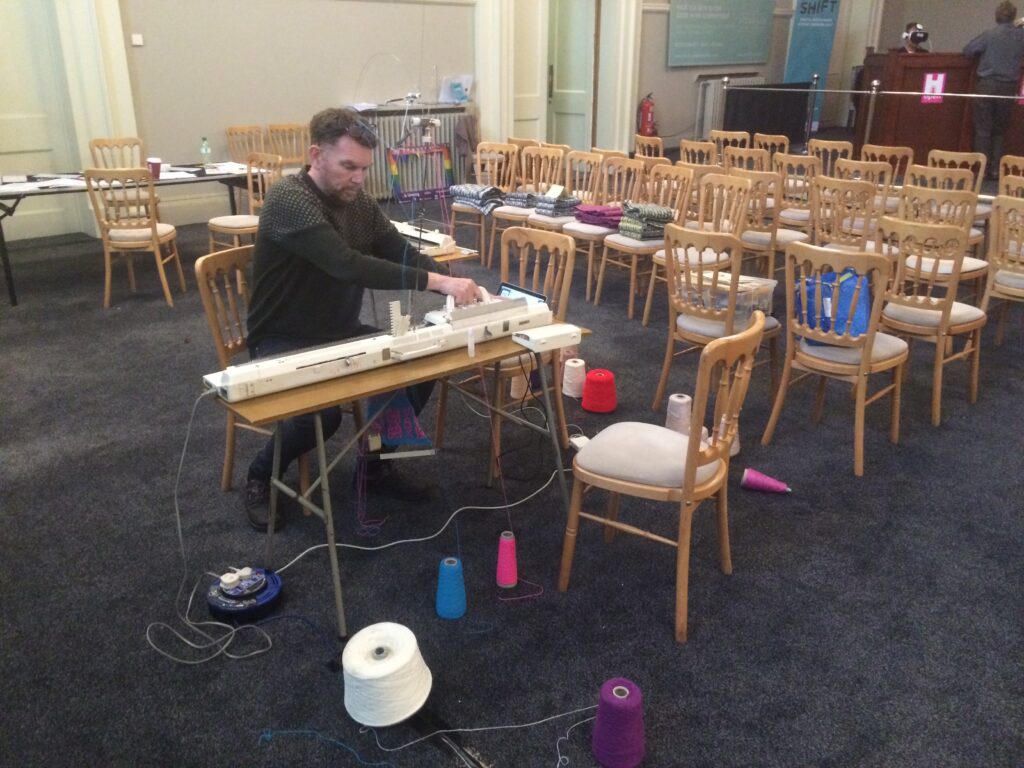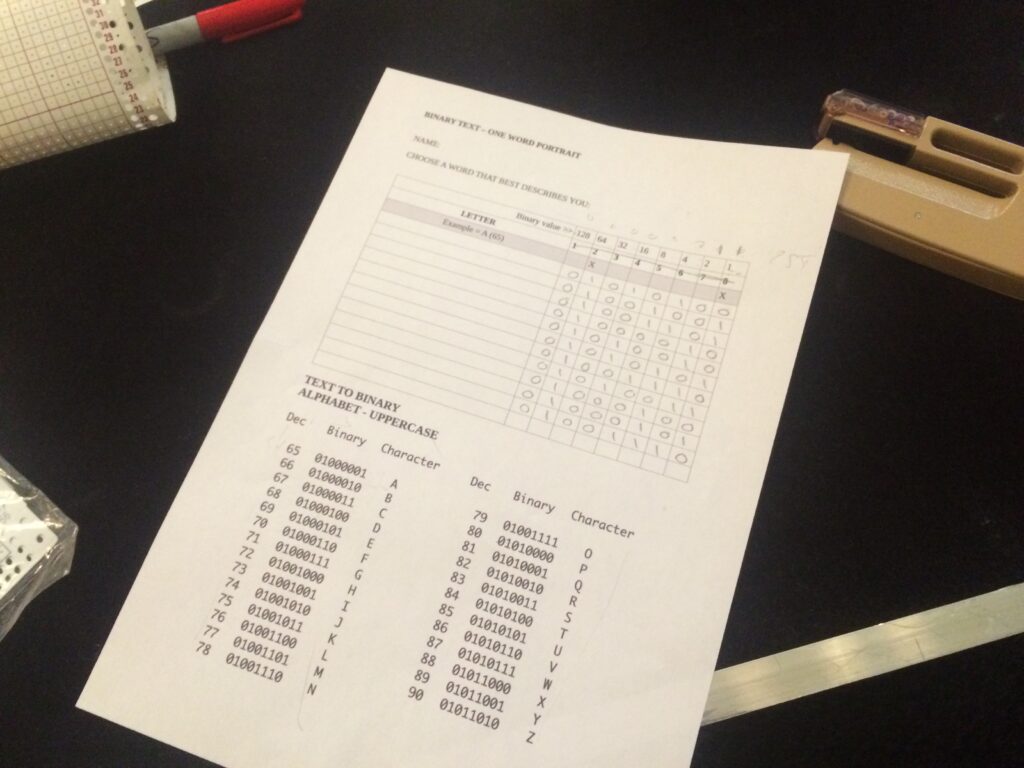 workshop
workshop
Knitting machine workshop
Sam Meech ran a knitting machine workshop on the last day of the festival. He talks about how it went.
My involvement with the project first came about through a series of scarves I’d designed inspired by Alan Turing. At first the connection between Turing and knitting might not be apparent, but the development of textiles technology and computers go hand in hand. Jacquard looms were programmed using punchcards – a system that formed the interface for early computers. The notion of encoding information, patterns and functions on the punchcard applies to both technologies. Amazing fact: Brother, who made the domestic knitting machines that I use in workshops, and many other textiles machines for industry, are better known for producing computers and printers, and based their headquarters in Manchester in 1968. The parallels between textiles and computing are historic but also embedded in the design process itself – what is knitting but a digital system, only using stitches instead of 0s and 1s?
 I enjoy using domestic knitting machines to give people a chance to get knitting but also learn about digital design. The machines themselves often attract the attention and curiosity of all ages. People either encounter them for the first time, or they have fond memories of a mother or grandmother knitting away on one. I found myself having many conversations with people about the mechanics, but also the opportunities for design that they offer. Each person brings their own skills and interests – from suggesting it could be a way of expressing data to archiving personal stories, or even writing music (echoing the way Ada Lovelace envisioned the potential of Babbage’s Analytical Engine’). The power of knitting is that it is disarmingly familiar, and so people feel qualified to make their own digital designs and encrypted knits. The added bonus of course is that you can wear your digital art.
Within Re-dock we often refer to the idea – “simple interface, complex interaction”. I find that knitting provides a way into complex ideas for a broad audience, allowing them to take part in creative discussions around digital technology, and quickly make their own work. The punchcard interface is a physical form of pixel art, allowing people to create digital designs easily through a simple tactile medium. It’s computing without computers.
I enjoy using domestic knitting machines to give people a chance to get knitting but also learn about digital design. The machines themselves often attract the attention and curiosity of all ages. People either encounter them for the first time, or they have fond memories of a mother or grandmother knitting away on one. I found myself having many conversations with people about the mechanics, but also the opportunities for design that they offer. Each person brings their own skills and interests – from suggesting it could be a way of expressing data to archiving personal stories, or even writing music (echoing the way Ada Lovelace envisioned the potential of Babbage’s Analytical Engine’). The power of knitting is that it is disarmingly familiar, and so people feel qualified to make their own digital designs and encrypted knits. The added bonus of course is that you can wear your digital art.
Within Re-dock we often refer to the idea – “simple interface, complex interaction”. I find that knitting provides a way into complex ideas for a broad audience, allowing them to take part in creative discussions around digital technology, and quickly make their own work. The punchcard interface is a physical form of pixel art, allowing people to create digital designs easily through a simple tactile medium. It’s computing without computers.
 For the HOD workshop I used the knitting machines to explore an idea that underpins modern computing – the use of binary and the ascii character encoding system. Using a simple reference worksheet, participants were able to translate their name to a binary value, expressed as eight 0s and 1s for each character. This requires a very small amount of maths using the binary table (eg, to make 65 from a ‘64’ and a ‘1’ to express ‘A’), but it is achievable for all ages. Children enjoyed the challenge of the puzzle, and parents enjoyed working through it with them. The reward of course is that they essentially make a knitting pattern and swatch that represents something personal, that only those with the code can understand. They understand something about textiles production, but also something about encryption, and binary values and computing.
It was a busy day, made richer by the fact it was talking place in the context of the VR experience and in the courtroom itself. I was warmed by feedback from Rob (who played Alan Turing in the production), who brought his children to the workshop:
For the HOD workshop I used the knitting machines to explore an idea that underpins modern computing – the use of binary and the ascii character encoding system. Using a simple reference worksheet, participants were able to translate their name to a binary value, expressed as eight 0s and 1s for each character. This requires a very small amount of maths using the binary table (eg, to make 65 from a ‘64’ and a ‘1’ to express ‘A’), but it is achievable for all ages. Children enjoyed the challenge of the puzzle, and parents enjoyed working through it with them. The reward of course is that they essentially make a knitting pattern and swatch that represents something personal, that only those with the code can understand. They understand something about textiles production, but also something about encryption, and binary values and computing.
It was a busy day, made richer by the fact it was talking place in the context of the VR experience and in the courtroom itself. I was warmed by feedback from Rob (who played Alan Turing in the production), who brought his children to the workshop:
 I enjoy using domestic knitting machines to give people a chance to get knitting but also learn about digital design. The machines themselves often attract the attention and curiosity of all ages. People either encounter them for the first time, or they have fond memories of a mother or grandmother knitting away on one. I found myself having many conversations with people about the mechanics, but also the opportunities for design that they offer. Each person brings their own skills and interests – from suggesting it could be a way of expressing data to archiving personal stories, or even writing music (echoing the way Ada Lovelace envisioned the potential of Babbage’s Analytical Engine’). The power of knitting is that it is disarmingly familiar, and so people feel qualified to make their own digital designs and encrypted knits. The added bonus of course is that you can wear your digital art.
Within Re-dock we often refer to the idea – “simple interface, complex interaction”. I find that knitting provides a way into complex ideas for a broad audience, allowing them to take part in creative discussions around digital technology, and quickly make their own work. The punchcard interface is a physical form of pixel art, allowing people to create digital designs easily through a simple tactile medium. It’s computing without computers.
I enjoy using domestic knitting machines to give people a chance to get knitting but also learn about digital design. The machines themselves often attract the attention and curiosity of all ages. People either encounter them for the first time, or they have fond memories of a mother or grandmother knitting away on one. I found myself having many conversations with people about the mechanics, but also the opportunities for design that they offer. Each person brings their own skills and interests – from suggesting it could be a way of expressing data to archiving personal stories, or even writing music (echoing the way Ada Lovelace envisioned the potential of Babbage’s Analytical Engine’). The power of knitting is that it is disarmingly familiar, and so people feel qualified to make their own digital designs and encrypted knits. The added bonus of course is that you can wear your digital art.
Within Re-dock we often refer to the idea – “simple interface, complex interaction”. I find that knitting provides a way into complex ideas for a broad audience, allowing them to take part in creative discussions around digital technology, and quickly make their own work. The punchcard interface is a physical form of pixel art, allowing people to create digital designs easily through a simple tactile medium. It’s computing without computers.
 For the HOD workshop I used the knitting machines to explore an idea that underpins modern computing – the use of binary and the ascii character encoding system. Using a simple reference worksheet, participants were able to translate their name to a binary value, expressed as eight 0s and 1s for each character. This requires a very small amount of maths using the binary table (eg, to make 65 from a ‘64’ and a ‘1’ to express ‘A’), but it is achievable for all ages. Children enjoyed the challenge of the puzzle, and parents enjoyed working through it with them. The reward of course is that they essentially make a knitting pattern and swatch that represents something personal, that only those with the code can understand. They understand something about textiles production, but also something about encryption, and binary values and computing.
It was a busy day, made richer by the fact it was talking place in the context of the VR experience and in the courtroom itself. I was warmed by feedback from Rob (who played Alan Turing in the production), who brought his children to the workshop:
For the HOD workshop I used the knitting machines to explore an idea that underpins modern computing – the use of binary and the ascii character encoding system. Using a simple reference worksheet, participants were able to translate their name to a binary value, expressed as eight 0s and 1s for each character. This requires a very small amount of maths using the binary table (eg, to make 65 from a ‘64’ and a ‘1’ to express ‘A’), but it is achievable for all ages. Children enjoyed the challenge of the puzzle, and parents enjoyed working through it with them. The reward of course is that they essentially make a knitting pattern and swatch that represents something personal, that only those with the code can understand. They understand something about textiles production, but also something about encryption, and binary values and computing.
It was a busy day, made richer by the fact it was talking place in the context of the VR experience and in the courtroom itself. I was warmed by feedback from Rob (who played Alan Turing in the production), who brought his children to the workshop:
They spoke of it for the rest of the day, and showed off the piece of knitting that they’d made with you; to family, to the waitress in the cafe at lunch, to the man behind the till in Tesco… to complete strangers we passed by! In each case they’d carefully explain what the pattern meant, how it was come by, and how the knitting was made.For me, to provide a young person with that small opportunity to explore a new world feels like a potentially powerful thing. Perhaps it might inspire the Lovelace and Turing of the future? So, to return to the knit pattern that inspired my workshop, here is a quote by Alan Turing, expressed in binary: 01001101 01100001 01100011 01101000 01101001 01101110 01100101 01110011 00100000 01110100 01100001 01101011 01100101 00100000 01101101 01100101 00100000 01100010 01111001 00100000 01110011 01110101 01110010 01110000 01110010 01101001 01110011 01100101 00100000 01110111 01101001 01110100 01101000 00100000 01100111 01110010 01100101 01100001 01110100 00100000 01100110 01110010 01100101 01110001 01110101 01100101 01101110 01100011 01111001 00101110 00100000 01000001 01101100 01100001 01101110 00100000 01010100 01110101 01110010 01101001 01101110 01100111 00001101 00001010 (Machines take me by surprise with great frequency – Alan Turing)